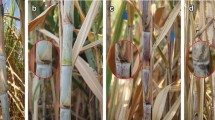Abstract
Ethylene evolution of leaf and contents of ABA and IAA in cane-tip were measured during late growth stage of sugarcane. The ethylene evolution of different leaves (the leaf with TVD was defined as leaf +1, other leaves were count downward) showed that the younger leaves had higher ethylene release rates and the older leaves lower. This indicated that the ethylene evolution in leaf was not associated with leaf ripening or senescence but possibly depended on the physiology of whole plants. There appeared ethylene evolution peaks at the onset of ripening process in all varieties examined. These ethylene peaks were more than triple of normal. The ABA accumulation characters varied from varieties. The ABA peak appeared at the onset of ripening, one or two week(s) before the ethylene peak presented, for Guitang15 and ROC16 but no discernible ABA peak for Guitang11. These results indicated that both ethylene and ABA would play roles in inducing ripening of sugarcane. And divers mechanisms of hormones action or interaction were suggested. IAA content increased at the early time of ripening stage, indicated that IAA did not play opposing role to ABA and ethylene in the ripening of sugarcane.
Similar content being viewed by others
Abbreviations
- TVD:
-
top visible dewlap.
Literature Cited
Coombe, B.G. (1992). Research on development and ripening of the grape berry.Am J Enol Vitic,43: 101–110.
Coombe, B.G. and Hale, C.R. (1973). The hormone content of ripening grape berries and the effect of growth substance treatment.Plant Physiol.,51: 629–634.
Eastwood, D. and Davis, H.B. (1997). Chemical ripening in Guyana/3-progress and prospects.Sugarcane 3: 4–17.
Finkelstein, R.R., Tenbarge, K.M., Shumway, J.E. and Crouch, M.L. (1985). Role of ABA in maturation of rapeseed embryos.Plant Physiol.,81: 907–912.
Fujino, D.W., Burger, D.W., Yang, S.F. and Bradford, K.J. (1988). Characterization of an ethylene overproducing mutant of tomato (Lycopersicon esculentum Mill. Cultivar VFN8).Plant Physiol.,88: 774–779.
Gepstein, S. and Thimann, K.V. (1981). The role of ethylene in the senescence of oat leaves.Plant Physiol.,68: 349–354.
Goldschmidt, E.E., Goren, R., Evenchen, Z. and Bittner, S. (1973). Increase in free and bound abscisic acid during nature and ethylene-induced senescence of citrus fruit peel.Plant Physiol.,51: 879–882.
Hamilton, A.J., Lycett, G.W. and Grierson, D. (1990). Antisense gene that inhibits synthesis of the hormone ethylene in transgenic plants.Nature,346: 284–287.
Kande, H. (1993). Ethylene biosynthesis.Annu Rev Plant Physiol Plant Mol Biol.,44: 283–307.
Kano, Y. and Asahira, T. (1981). Roles of cytokinin and abscisic acid in maturing of strawberry fruit.J Japan Soc Hort Sci.,50: 31–36
Lanahan, M.B., Yen, H.C., Giovannoni, J.J. and Klee, H.J. (1994). TheNever-ripe mutation blocks ethylene perception in tomato.Plant Cell,6: 521–530.
Lavee, S. and Martin, G.C. (1981). Ethylene evolution following treatment with 1-aminocyclopropane-l-carboxylic acid and ethephon in anin vitro olive shoot system in relation to leaf abscission.Plant Physiol.,67: 1204–1207.
Legendre, B.L. (1975). Ripening of sugarcane: effects of sunlight, temperature, and rainfall.Crop Science,15: 349–352.
Lieberman, M. (1979). Biosynthesis and action of ethylene.Ann Rev Plant Physiol.,30: 533–591.
Lingle, S.E. and Smith, R.C. (1991). Sucrose metabolism related to growth and ripening in sugarcane internodes.Crop Science,31: 172–177.
Oeller, P.W., Min-Wong, I., Tailor, L.P. and Pike, D.A. (1991). Reversible inhibition of tomato fruit senescence by antisense RNA.Science,254: 437–439.
Ronene, M. and Mayak, S. (1981). Interrelationship between abscisic acid and ethylene in the control of senescence processes in carnation flowers.J. Exp. Bot.,32: 759–769.
Suttle, J.C. and Hultstrand, J.F. (1993). Involvement of abscisic acid in ethylene-induced cotyledon abscission in cotton seedlings.Plant Physiol.,101: 641–646.
Woodson, W.R., Park, K.Y., Drory, A., Larsen, P.B. and Wang, H. (1992). Expression of ethylene biosynthetic pathway transcripts in senescing carnation flowers.Plant Physiol.,99: 526–532.
Yang, S.F. and Hoffman, N.E. (1984). Ethylene biosynthesis and its regulation in higher plants.Ann Rev Plant Physiol,35: 155–189.
Yao, R.L., Li, Y.R. and Yang, L.T. (2000). Effects of ethephon on ripening and increasing sucrose content in mature and immature internodes of sugarcane.Southwest China J of Agric Sci.,13: 89–94.
Zeevaart, J.A.D. and Creelman, R.A. (1988). Metabolism and physiology of abscisic acid.Ann Rev Plant Physiol.,39: 439–473.
Author information
Authors and Affiliations
Corresponding author
Additional information
Supported by China National Natural Science Foundation (39860039)




